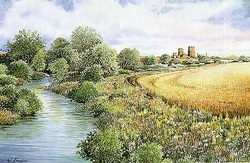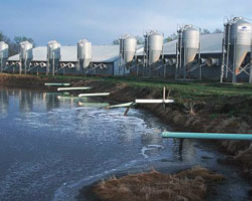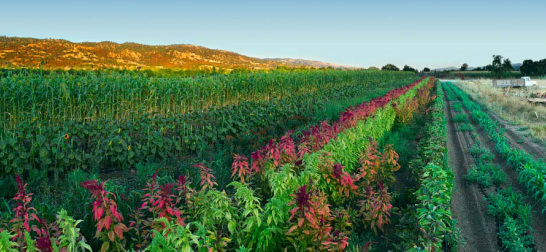Sustainability and Flexibility

No element in farming is separate from any other element; and by the same token, the farm is an integral part of the environment, culture,and the society in which it exists. There is a beautiful symmetry and harmony to a farm that assumes a holistic approach.
Balance and the Agro-Environment
The notion of agroecology is, in its essence, farming in an environmentally sensitive manner, using science and knowledge as allies to work with, rather than defeat, nature. The elegance and logical nature of this approach goes far beyond the physical act of farming though, and can easily be viewed in contexts that include ethics, morality and even broad philosophical concepts. The trick and the challenge in establishing sound agroecosystems is to, in some manner insert the human element into the natural environment and minimize the human footprint within that environment while manipulating that same environment to produce food. This is a balancing act of seemingly epic proportions, but achievable even on a global scale. The concept of achieving and maintaining this balance is an important, core-theme that underlies the work of John H. Vandermeer in his book, The Ecology of Agroecosystems, which is an important inspiration for this page. (1)
Balance and the Agro-Environment
The notion of agroecology is, in its essence, farming in an environmentally sensitive manner, using science and knowledge as allies to work with, rather than defeat, nature. The elegance and logical nature of this approach goes far beyond the physical act of farming though, and can easily be viewed in contexts that include ethics, morality and even broad philosophical concepts. The trick and the challenge in establishing sound agroecosystems is to, in some manner insert the human element into the natural environment and minimize the human footprint within that environment while manipulating that same environment to produce food. This is a balancing act of seemingly epic proportions, but achievable even on a global scale. The concept of achieving and maintaining this balance is an important, core-theme that underlies the work of John H. Vandermeer in his book, The Ecology of Agroecosystems, which is an important inspiration for this page. (1)
Table 1. Comparison of the Corporate/Factory Farm Model and Sustainable/Holistic 21st Century Small Small Farm (based on OSU research model)
|
Corporate/Factory Farm Model/CAFOs*
Energy intensive: Outside inputs, specifically petroleum based fertilizers, pesticides, and large fuel consumption. Mainly because of rising crude oil prices net farm income in 2009 is 21% below 1970 levels. (2) Linear process: Based on outside inputs grown or provided by specialists, i.e.: corn farmers, feed producers, fuel suppliers. There is little opportunity to recycle or establish cycles that would benefit the operation or acreage on which the operation conducts business. This m.o. creates a system that puts the farm in a position in which it must fight natural cycles or create conditions counter to these cycles. In many cases, valuable manure by-products are shipped from the physical location, while market outlets require shipping to distant processing facilities; both actions significantly increase the carbon footprint of the operation. (3)(4) Farm as a factory: To produce cheap food and maximize profits, the farm must specialize and tool-up for the specialization of growing a limited spectrum of crops or raising one specie of animal for meat production, creating mono or limited culture scenarios subject to severe reactions to market swings as well as plant, or animal health problems.Domination over nature is a key element in the methodology of the "farm as a factory." Low-value products: With the goal of increased productivity at the lowest price, quality and ethical considerations are not tantamount in pursuit of other plant or animal characteristics that result in a high volume, low-margin product for a mass market. ie: hard-shippable tomatoes at the loss of taste or texture, meat (cattle) that is specifically bred to look and taste a specfic way regardless of its nutritional value or the conditions in which the animal was raised for slaughter.(5)(6) Single-use equipment : Within the confines of the specificity involved in agriculture based on monoculture or single animal production comes the need of specialized (particularly harvesting) equipment. The farmer essentially must "lock-up"and lose any vestige of crop or market flexibility in order to justify the high capital costs of specialized equipment.(7) Passive marketing : Because high volumes of a limited number of products must be moved (sold) to profit from relatively low margins(profits) often shared with shareholders, bankers, and/or investors, the farmer loses flexibility and the ability to react to either favorable or unfavorable market conditions. To justify and finance these high-capital operations, long-term contracts are often requisite for independently owned CAFOs*; due to the fact that 80% of the meat packing/slaughter industry is controlled by Tyson, Cargill and Swift in the united States.(8) * Concentrated (or confined) Animal Feeding Operations |
Sustainable/Holistic Model
Information intensive: Methodology is predicated on the ability to react and adjust to natural and manmade conditions. Awareness of the farm is an integral part of an infinite set of cycles and the environment in total. Strive for low-inputs. Education and constant updating of knowledge are key.(9)(10) Cyclical process : The recognition that every action taken on the farm, whether it be plowing, spreading manure, or planting a seed, is linked to every other action in some manner, is a core principle of sustainibility. From the soil-nutrient cycles to water cycles to energy cycles, understanding these systems and how they are linked creates a management system that works within nature and not against it. Crop selection based on elements that take advantage of and contributes to the existing cycles increases profit by reducing outside inputs.This in turn, makes the farmer less reliant on outside vendors, and reduces the carbon footprint of the farm.(11)(12) Farm as ecosystem: In an ecosysytem, inputs and outputs must be in balance. " When we try to pick anything out by itself, we find that it is hitched to everything else in the universe." remarked photograher and naturalist John Muir. The ecosystem of the farm is composed of plants, animals, and millions of microorganisms acting in unision with the mineral/non-living elements; with man's primary role as a catalyst. In the sustainable model, man exacerbates the functioning of these natural systems to obtain a profit while causing the least amount of disruption to these natural systems.(13)(14) Enterprise integration and community : All that happens on the farm effects the community in which the farm exists. Trade and social interaction among the farm and the greater community are key to the tenets of the sustainable farm and all the enterprises it represents. The farm is represented by both the quality of the product it produces and by the sense of responsibility it assumes as a contibuting member of the community at large.(15) Many enterprises and multiple-use equipment: Short term production efficiences/profits are often achieved within the factory farm scenariowhen all market conditions are favorable but this "mono-type" is extremely vulnerable to market flucuations caused by scenarios such as as low-bid competition, surpluses, and changing consumer preferences. While some efficiences in production are sacrificed in the sustainable model, built-in mitigators through diversity of crops and multi-purpose equipment even out uncontollable negative market forces.(16) Active marketing : The sustainable model relies on aggressive and on-going marketing strategies that must change and adjust to conditions such as supply, quality, and trends and eating habits of consumers mainly in the context of local markets (though there are marketing opportunities via the Interenet as far reaching as 'globally.') Because quality translates to customer satisfaction and premium pricing, the sustainable model has a built-in incentive to strive for the best possible product. The practice of aggressive quality marketing hones the farmer's agility which in turn seques to flexibility and innovation in other areas of the farm.(17) |

